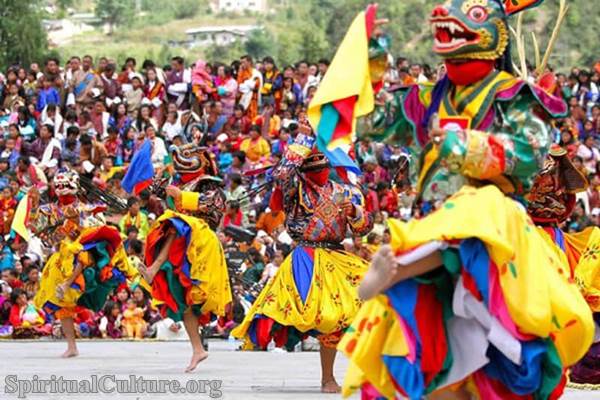The spirit of Japan is not found solely in its serene temples or meticulously planned gardens, but bursts forth in its vibrant calendar of festivals, known as matsuri. These events are far more than mere celebrations; they are deeply sacred and historical expressions of the nation’s spiritual relationship with its deities (kami), ancestors, and the cyclical rhythm of nature. From Shinto rituals to Buddhist observances, each festival is a living link to centuries of heritage, drawing communities together in collective acts of purification, gratitude, and prayer for prosperity.
At Spiritual Culture, we assess the greatness of these events not just by the size of the crowd they draw, but by their profound historical longevity, depth of spiritual meaning, and cultural influence across the archipelago. The festivals ranked here, verified as of the Current Time of Writing, represent the pinnacle of Japanese cultural heritage, where ancient tradition meets modern vibrancy.
This authoritative guide moves beyond surface-level popularity, focusing on the core purpose of the rituals. It highlights the enduring spiritual impact these events have on the local communities and the world, cementing their status as indispensable elements of Japan’s soul.
Table of the Top 10 Japanese Festivals by Spiritual and Historical Significance
The following ranking reflects the depth of history, religious ritual, and ongoing cultural impact of Japan’s most renowned annual events.
| Rank | Festival Name | Location | Primary Spiritual Origin | Key Significance |
|---|---|---|---|---|
| 1 | Gion Matsuri | Kyoto | Shinto (Placation of Vengeful Spirits/Plague Ward) | One of the “Three Great Festivals of Japan,” longest continuous history (since 869 CE). |
| 2 | Tenjin Matsuri | Osaka | Shinto (Honoring Sugawara no Michizane, God of Scholarship) | One of the “Three Great Festivals of Japan,” famous for its land and river procession (Funatogyo). |
| 3 | Bon Festival (Obon) | Nationwide | Buddhist/Folk (Honoring Ancestral Spirits) | Nation’s most important spiritual holiday; a time for families to reunite and guide ancestral spirits home. |
| 4 | Kanda Matsuri | Tokyo | Shinto (Prosperity & Fortune/Disaster Prevention) | One of the “Three Great Festivals of Japan” (or Edo’s Big Three), featuring mass mikoshi parades. |
| 5 | Aomori Nebuta Festival | Aomori | Folk/Shinto (Dispelling Summer Lethargy/Evil Spirits) | Known for its massive, illuminated warrior-figure lantern floats (nebuta). |
| 6 | Awa Odori | Tokushima | Buddhist/Folk (Obon Dance) | Japan’s most famous and largest traditional dance festival, celebrating life and ancestral memory. |
| 7 | Takayama Matsuri | Takayama, Gifu | Shinto (Honoring Good Harvest and Community) | Twice-yearly festival famed for its ancient, elaborate puppet floats (karakuri ningyo). |
| 8 | Shogatsu (New Year) | Nationwide | Shinto/Buddhist (Purification and Welcoming the Kami) | The most important annual celebration, focused on purification and praying for good fortune. |
| 9 | Sapporo Snow Festival (Yuki Matsuri) | Sapporo, Hokkaido | Modern/Cultural (Community, Art, & International Exchange) | The largest modern cultural festival, celebrating artistic expression and regional identity through snow and ice. |
| 10 | Tanabata Festival (Star Festival) | Nationwide (most famously Sendai) | Folk (Celestial Lovers Legend) | A poetic festival celebrating the meeting of the star-crossed lovers Orihime and Hikoboshi. |
Top 10 Most Famous Japanese Festivals
Top 10. Tanabata Festival (Star Festival)
The Tanabata Festival, traditionally held in July or August depending on the location and lunar calendar variations, is a romantic expression of folk spirituality across Japan. Rooted in the ancient Chinese legend of the celestial lovers Orihime (the Weaver Princess) and Hikoboshi (the Cowherd), who are separated by the Milky Way and permitted to meet only once a year, this festival is a celebration of human wishes and cosmic connections. Most famously celebrated in Sendai with spectacular, colorful streamer decorations, participants write their hopes and dreams onto small strips of paper called tanzaku and hang them on bamboo branches, trusting the heavens to grant them.

Its spiritual impact is gentle yet profound, emphasizing the power of yearning, patience, and the human desire for skill improvement and good fortune. By hanging the tanzaku, participants engage in a quiet, collective ritual of petitioning the stars, bridging the physical and celestial worlds. This practice echoes the traditional Shinto concept that all of nature—including the stars—is imbued with spiritual presence, and that human intention can communicate with these powers, promoting personal growth and artistry.
The enduring power of Tanabata lies in its moral lesson: that true love and aspiration can overcome vast distances and difficult circumstances, even if only for a single, precious night. It reminds practitioners that even separated from a goal, the act of striving and holding onto hope (symbolized by the hanging wish) is a spiritual discipline in itself. It is a beautiful, understated tradition that celebrates the simple yet profound magic of believing.
Cultural/Spiritual Highlights:
- Originates from the Chinese Qixi Festival, merging with indigenous Japanese beliefs.
- Wishes (tanzaku) are traditionally written on one of the five colors, each representing a virtue: courtesy, wisdom, righteousness, fidelity, and justice.
- Celebrates Orihime (a weaving goddess) and Hikoboshi (a celestial cowherd).
Top 9. Sapporo Snow Festival (Yuki Matsuri)
The Sapporo Snow Festival in Hokkaido, typically held in February, represents the pinnacle of modern, large-scale community cultural expression in Japan. While lacking the ancient Shinto or Buddhist origins of others on this list, its significance lies in its powerful demonstration of communal resilience, artistic innovation, and regional pride, which form a spiritual culture unique to the northern lands. What began in 1950 with a few high school students building snow statues has rapidly become a world-renowned spectacle, featuring massive snow sculptures and crystalline ice art that draw millions of international and domestic visitors.

We rank this festival here for its immense cultural impact as a unifying civic event and a symbol of human creativity triumphing over the harsh elements of winter. It celebrates the collaborative spirit (wa) of the community, where military personnel, local residents, and international teams work side-by-side to create temporary, breathtaking works of art. The spiritual message is one of transformation and appreciation: turning the raw, cold materials of snow and ice into structures that evoke wonder, demonstrating that beauty can be found even in the most severe environments.
The Sapporo Snow Festival serves as a powerful testament to the idea that culture is a living, evolving entity. Its value lies in the humanistic celebration of the present and the future, showcasing a uniquely Japanese reverence for artistry and scale. It inspires a moral lesson of temporary beauty, reminding all participants to appreciate the ephemeral nature of all things, as these grand structures melt away, leaving only the memory of their splendor.
Cultural/Spiritual Highlights:
- It is the largest and most commercially significant winter festival in Japan, drawing over 2 million annual visitors.
- Focuses on international friendship and artistic expression, featuring a global ice carving competition.
- Represents the regional identity of Hokkaido and the triumph of community spirit over winter.
Top 8. Shogatsu (New Year)
Shogatsu, the Japanese New Year celebration, is unquestionably the nation’s most important annual spiritual holiday, even though it is often considered a cluster of customs rather than a single “festival.” Observed broadly from December 31st to January 3rd, it is an intense period of purification, renewal, and family bonding. Preparations include a thorough house cleaning (osoji) to sweep away the dust of the old year, followed by the ringing of temple bells 108 times (joya no kane) at midnight to cleanse the 108 worldly sins, culminating in the first shrine or temple visit (hatsumode) to pray for good fortune.
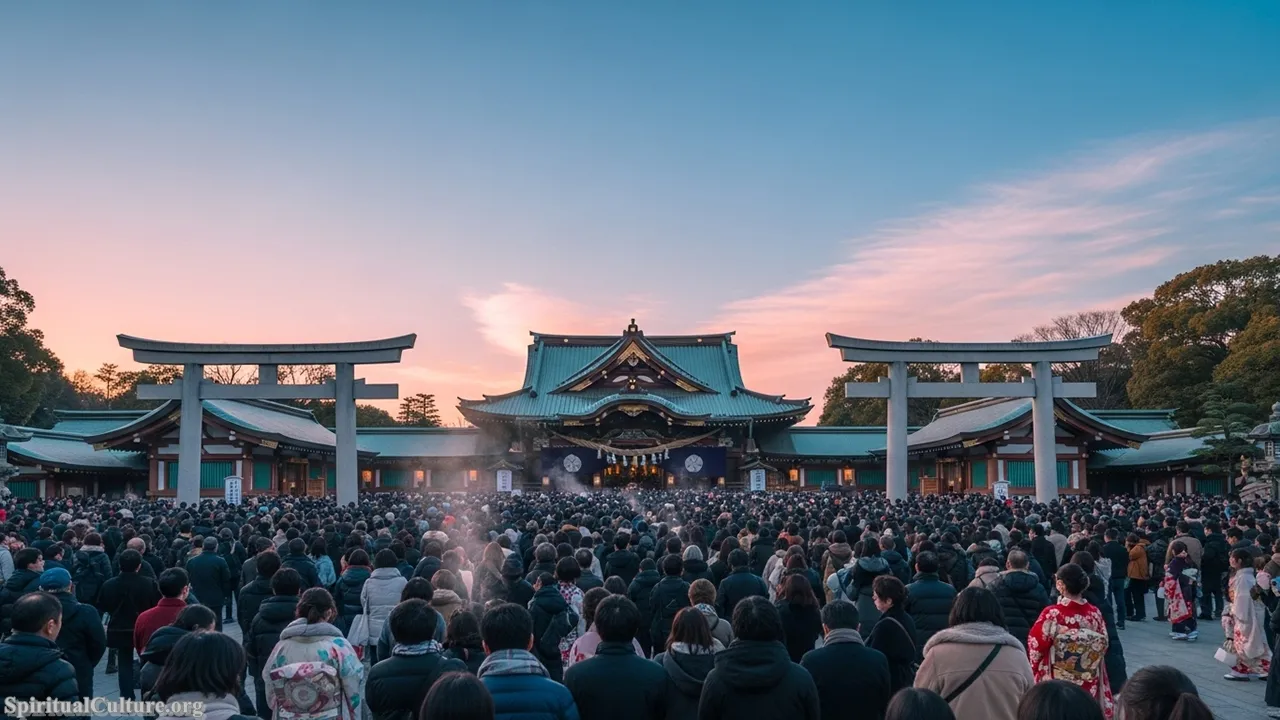
Its reason for ranking is due to its unparalleled, nationwide spiritual impact on every single Japanese citizen, transcending all regional and sectoral differences. The fundamental spiritual purpose is to banish evil and welcome the auspicious kami (deities), particularly the New Year God (Toshigami-sama), who brings good harvest and ancestral blessing. This is a crucial time for honoring ancestors, expressing gratitude, and resetting one’s personal and communal life with purity and intention, a profound expression of collective Shinto/Buddhist syncretism.
Shogatsu’s preservation value is absolute; it is the definitive moment of cultural continuity. The moral lesson is the vital necessity of annual spiritual renewal. By meticulously preparing the home, purifying the spirit, and dedicating the first moments of the year to the sacred, the entire nation affirms its commitment to living a life of virtue and receiving the blessings of the divine. It is a profound, meditative, and celebratory expression of hope.
Cultural/Spiritual Highlights:
- The Joya no Kane tradition of ringing temple bells 108 times symbolizes the cleansing of 108 worldly desires.
- It is the peak period for Hatsumode, the first spiritual visit of the year to a shrine or temple.
- Involves specific foods (osechi-ryori) and decorations (kadomatsu, shimenawa) to welcome the New Year God (Toshigami-sama).
Top 7. Takayama Matsuri
The Takayama Matsuri is a revered twice-yearly Shinto festival held in Takayama, Gifu Prefecture, celebrated as the Sanno Matsuri in spring (April) and the Hachiman Matsuri in autumn (October). Often cited as one of Japan’s most beautiful festivals, it is famous for its towering, exquisitely decorated floats (yatai), some of which carry intricate mechanical puppets known as karakuri ningyo. With origins tracing back to the 17th century, this festival is a dedication to the local shrines, celebrating bountiful harvest and the unity of the mountain community.

This festival’s place on the list is secured by the astonishing level of artistry and preservation of the floats themselves, which are treated as invaluable cultural treasures. The spiritual impact is deeply intertwined with gratitude for the local mountain kami and the celebration of the changing seasons—the spring festival prays for a good year, and the autumn festival gives thanks for the harvest. The karakuri ningyo performances are not just entertainment; they are sacred offerings, demonstrating human skill and dedication to the deities in an act of artistic devotion.
The preservation value of the Takayama Matsuri is extraordinary, with the floats themselves designated as Important Tangible Folk Cultural Properties. Its reflection lies in the profound pride of the craftspeople who maintain these cultural assets, teaching us that spiritual heritage is upheld through meticulous effort and generational knowledge. The meticulous effort required to preserve and parade these ornate floats exemplifies a core Japanese value: the dedication to detail as an act of worship.
Cultural/Spiritual Highlights:
- Features intricate, towering floats (yatai) designated as Important Tangible Folk Cultural Properties.
- Celebrated twice annually to correspond with the spring (Sanno Matsuri) and autumn (Hachiman Matsuri) harvest cycles.
- Showcases karakuri ningyo, highly advanced mechanical puppets that perform for the kami.
Top 6. Awa Odori
The Awa Odori, held annually in Tokushima during mid-August, is arguably the most famous traditional folk dance festival in Japan. It is celebrated as part of the wider Obon season, and its history stretches back over 400 years. Characterized by its infectious rhythm, unique, slightly irregular steps, and the famous motto, “The dancers are fools, the watchers are fools; both are fools, so why not dance?”, the festival is a joyous and wild expression of communal spirit.
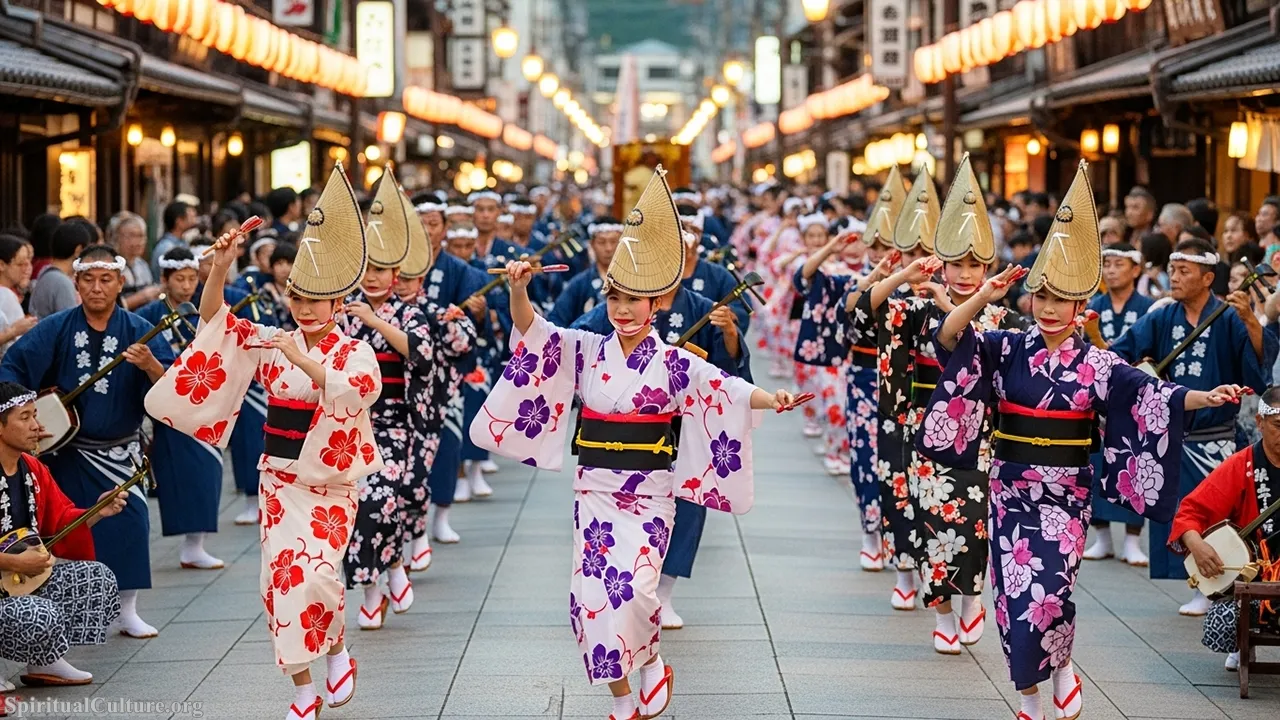
Its ranking is secured by its foundational link to the spiritual concept of Obon. The Awa Odori is a form of Bon Odori, the dance performed to honor and welcome the spirits of deceased ancestors. Unlike the solemnity of other Obon rituals, this dance uses joyful exuberance to express the gratitude and love felt for the ancestors, making it a powerful collective ritual for ancestral remembrance. The carefree nature reflects a spiritual abandonment, a moment when social hierarchies dissolve and everyone joins in the collective memory and celebration of life.
The reflection of Awa Odori offers a powerful moral lesson: that spiritual remembrance can and should be a source of profound joy and unity. It teaches that the act of moving together, regardless of skill or status, is a powerful human expression of spiritual unity. The sheer scale and communal participation ensure its preservation as a core element of Shikoku’s spiritual identity.
Cultural/Spiritual Highlights:
- The largest Bon Odori (Obon dance) in Japan, dedicated to honoring ancestral spirits.
- Known for its unique two-step rhythm and the carefree, inclusive philosophy.
- Held during the Obon period (mid-August), a time of national Buddhist observance.
Top 5. Aomori Nebuta Festival
Held in early August in Aomori City, the Nebuta Festival is a dramatic spectacle renowned for its gigantic, three-dimensional, lantern-lit floats, or nebuta, depicting heroic figures from Japanese and Chinese mythology, history, and Kabuki theater. These illuminated paper creations, often reaching up to nine meters wide, are wheeled through the streets to the accompaniment of pulsating taiko drums and traditional flute music, with participants chanting and dancing around them.

The spiritual essence of the Nebuta Festival is rooted in a ritual known as Nemuri Nagashi, a ritualistic practice meant to float away drowsiness or lethargy (thought to be caused by evil spirits) at the end of summer, purifying the body and soul for the coming harvest season. The large, powerful nebuta floats act as spiritual magnets, drawing out and containing these negative energies, which are then symbolically cast off into the river or sea on the final night. This collective, vigorous effort is a profound annual exorcism of weariness and malice.
The profound preservation value lies in the dedication required to construct these colossal, intricate artworks anew each year, a process taking months and involving master paper and frame artisans. The moral lesson is the necessity of purification through collective, powerful action. The festival teaches that through sound, light, and movement, the community can actively dispel spiritual and physical exhaustion to ensure vitality for the future.
Cultural/Spiritual Highlights:
- Originates from the Nemuri Nagashi ritual, a traditional practice to drive away drowsiness and evil spirits.
- Features massive, illuminated paper floats (nebuta) depicting warrior figures and mythological beings.
- A powerful ritual of community-wide purification and vitalization before the autumn season.
Top 4. Kanda Matsuri
The Kanda Matsuri is one of the three great Shinto festivals of Edo (old Tokyo) and ranks as one of Japan’s most famous, taking place in odd-numbered years at Kanda Myojin Shrine. Originally patronized by the Tokugawa Shogunate, the festival has a rich history tied to the protection and prosperity of the city, honoring three deities: Daikokuten (god of good harvest and wealth), Ebisu (god of fishing and business), and Taira Masakado (a deified historical figure for disaster prevention).
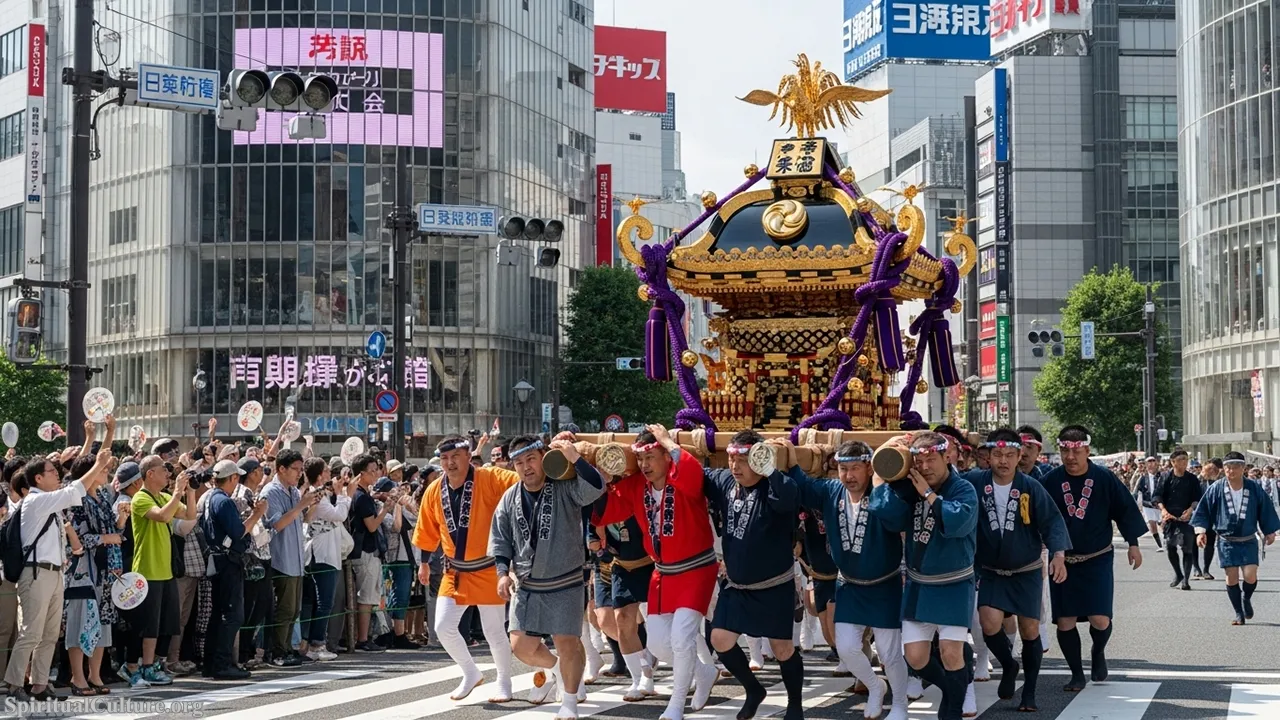
The core spiritual ritual involves the Shinkosai procession, where the spirits of the three deities are transferred into ornate portable shrines (mikoshi) and paraded through the heart of Tokyo. This sacred journey is believed to purify the neighborhoods and distribute blessings of prosperity and protection to the residents. Its high ranking is due to its cultural significance as a reflection of Tokyo’s history, symbolizing the power and wealth of the city’s early merchant class and the divine protection granted to the Shogun’s capital.
The festival’s reflective significance today highlights the blending of the sacred and the modern. The procession weaves through contemporary business districts like Akihabara and Otemachi, affirming that spiritual protection is still vital in the hyper-modern world. The moral lesson is that regardless of technological progress, the foundation of community well-being remains tied to honoring historical deities and maintaining a connection to the city’s protective spiritual roots, which are passionately maintained by the local ujiko (parishioners).
Cultural/Spiritual Highlights:
- One of the “Three Great Festivals of Edo,” celebrated in odd-numbered years in May.
- The main event is the Shinkosai, a sacred procession of mikoshi carrying the deities to purify the city.
- Deifies Taira Masakado, a powerful historical figure, for the spiritual protection of the capital.
Top 3. Bon Festival (Obon)
The Obon Festival, or Bon Festival, is a nationwide Buddhist custom held typically in mid-August (or mid-July in some areas). It is the annual time when the spirits of deceased ancestors are believed to return to their familial homes to visit the living. Unlike the more visually flamboyant festivals, Obon is a solemn, deeply personal, and communal spiritual holiday, focused on remembrance, filial piety, and familial reunion.
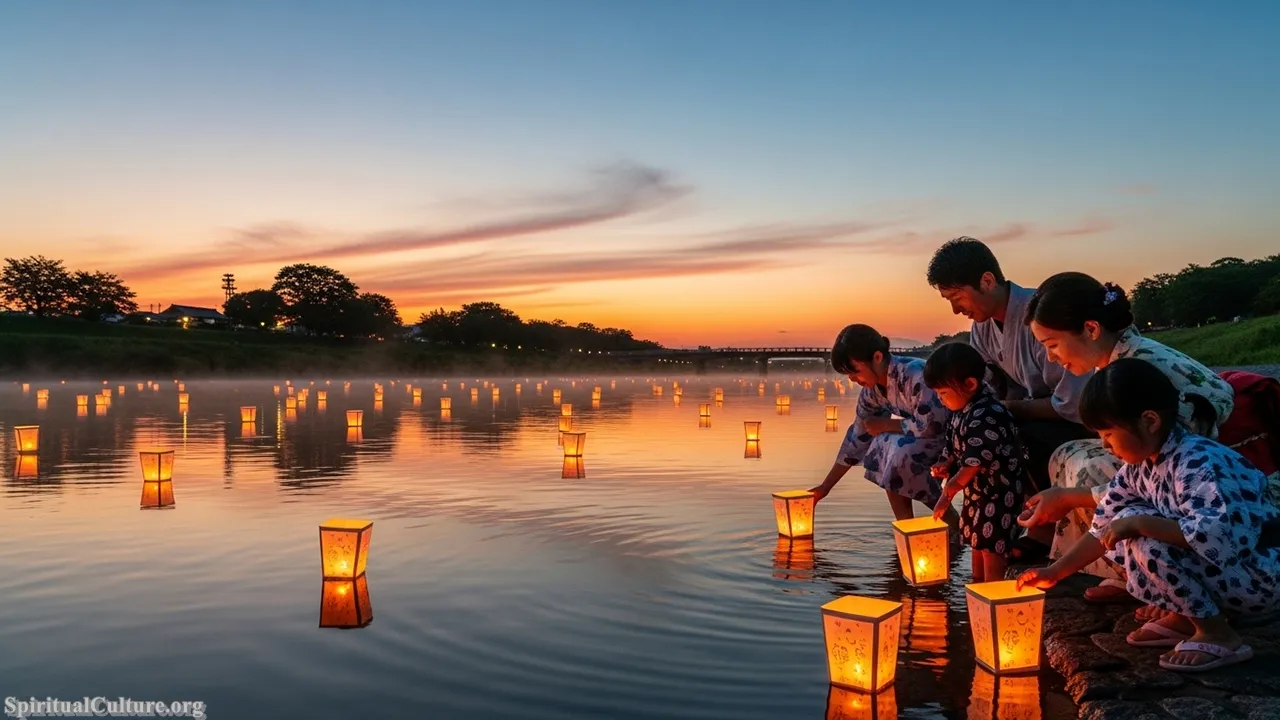
Its high ranking is a reflection of its ubiquitous and non-negotiable spiritual importance across nearly all Japanese households. The festival involves key rituals that are fundamental to Buddhist and Japanese folk belief: cleaning the ancestors’ graves, lighting small fires (mukaebi) to guide the spirits home, making offerings at the home altar (butsudan), and participating in communal Bon Odori dances. These are profound, ritualistic expressions of the cyclical nature of life and death, reinforcing family bonds across generations, both living and passed.
The preservation value of Obon is absolute, as it forms the bedrock of Japan’s ancestor veneration culture. Its moral lesson is the spiritual continuity of the family line, teaching that the dead are not truly gone but remain active participants in the life of the family. This annual reunion underscores the essential spiritual truth that honoring those who came before is paramount to achieving peace and prosperity in the present. It is the most moving and unifying spiritual observance in the nation.
Cultural/Spiritual Highlights:
- The most important Buddhist observance, dedicated to honoring and welcoming ancestral spirits back home.
- Involves ritualistic fires (mukaebi and okuribi) to guide the spirits’ arrival and departure.
- The spiritual purpose is rooted in the Buddhist tale of Maudgalyāyana (Mokuren) saving his mother from suffering.
Top 2. Tenjin Matsuri
The Tenjin Matsuri, held on July 24th and 25th in Osaka, is considered one of the “Three Great Festivals of Japan” and is the annual celebration of Osaka Tenmangū Shrine. It honors the deified scholar Sugawara no Michizane, who, after being unjustly exiled, was posthumously feared as a vengeful spirit (goryo) before being placated and elevated as Tenjin, the god of scholarship and learning. The festival, which dates back over a thousand years, is famed for its spectacular land procession and, most notably, its river procession (Funatogyo).

The spiritual significance is twofold: an appeasement of a powerful deified spirit, and a celebration of learning and cultural prosperity, reflecting Osaka’s identity as a commercial and intellectual hub. The climax is the Funatogyo, where a hundred boats carry the deity’s portable shrine down the Okawa River, culminating in a dazzling fireworks display that reflects upon the water. This “Festival of Fire and Water” is a symbolic journey of the god through the city he protects, spreading blessings to ensure the city’s economic health and its citizens’ success in their studies.
The profound preservation value is the magnificent synthesis of ritual and community spectacle. The festival’s reflection teaches a moral lesson about the power of learning and the spiritual journey of transformation—from a figure of tragedy and vengeance to one of intellectual benevolence. By celebrating the god of scholarship, the city reaffirms its commitment to wisdom and personal advancement as primary cultural virtues.
Cultural/Spiritual Highlights:
- One of the “Three Great Festivals of Japan,” celebrating Sugawara no Michizane, the deified god of scholarship (Tenjin).
- The climax is the magnificent Funatogyo (River Procession) of over 100 boats on the Okawa River.
- The ritual began as a way to appease Michizane’s vengeful spirit (goryo) after his unjust exile and death.
Top 1. Gion Matsuri
The Gion Matsuri, held throughout the month of July in Kyoto, stands as the most spiritually and historically significant festival in all of Japan, earning it the #1 rank in this Spiritual Culture guide. Its origins are firmly rooted in the year 869 CE, when Emperor Seiwa ordered a purification ritual (Goryo-e) to appease the vengeful spirits and plague-causing deities believed to be responsible for a devastating epidemic. The festival is named after the Gion district’s Yasaka Shrine and is now a UNESCO Intangible Cultural Heritage event, famous for its colossal, highly decorated floats known as Yamaboko.
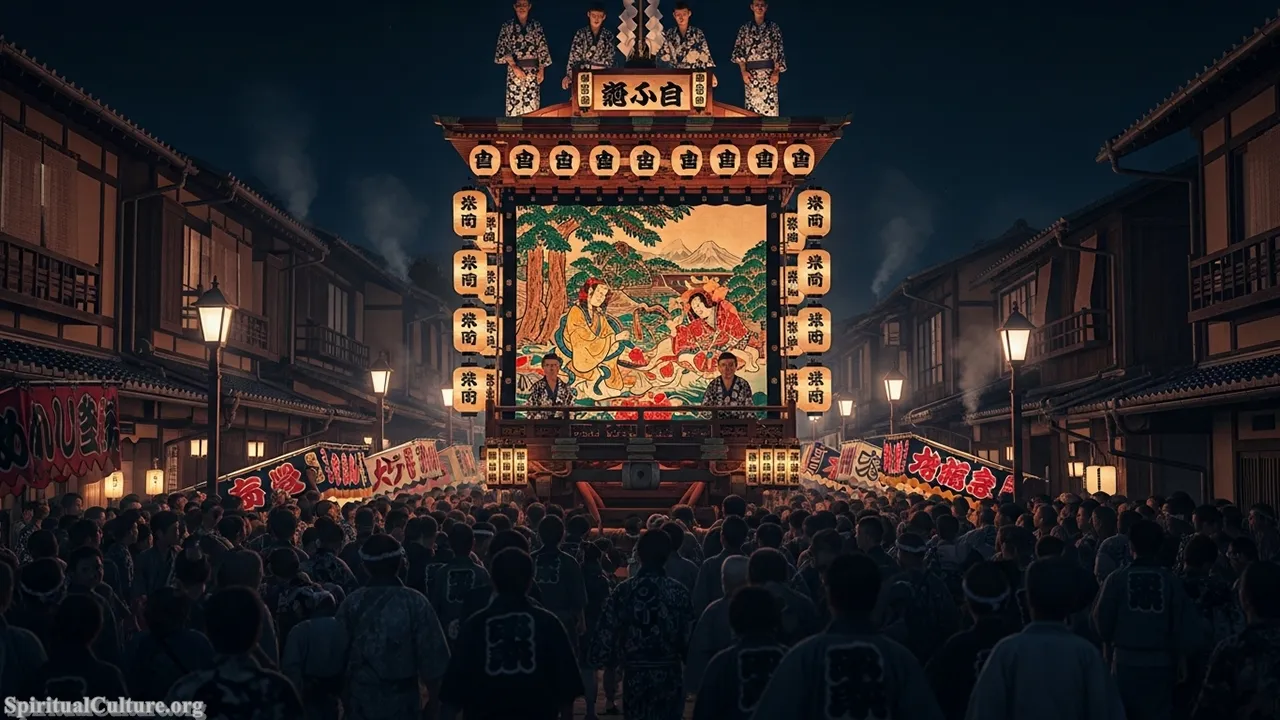
The depth of its spiritual impact and historical significance is unmatched. It represents the oldest and most continuous form of collective purification and spirit-appeasement in Japan, fundamentally tied to the health and survival of the ancient capital. The ritual of the Yamaboko Junko (float procession) is essentially a sacred act where the enormous floats, some serving as symbolic halberds, are paraded to draw out and contain impurities and malevolence, which are then cleansed from the city. The floats themselves are living museums, adorned with priceless tapestries and artwork, reflecting a centuries-long commitment to the highest forms of cultural offering.
The Gion Matsuri offers a critical reflection on the spiritual contract between the community and the divine: that collective suffering can be overcome through collective, structured, and beautiful ritual. Its preservation value, confirmed at the Current Time of Writing, is not merely in the objects but in the unbroken ritual practice spanning over a millennium. The moral lesson is the necessity of purification—the continuous, annual commitment to cleansing the community of unseen dangers to ensure peace and prosperity for all.
Cultural/Spiritual Highlights:
- Originates from the 869 CE Goryo-e purification ritual to appease plague-causing deities.
- Recognized by UNESCO as an Intangible Cultural Heritage of Humanity.
- The massive Yamaboko floats serve as symbolic structures for purification and spiritual cleansing.
- The Byobu Matsuri (Folding Screen Festival) involves local houses displaying ancestral art and heirlooms.
Reflective Conclusion: The Living Heritage of Matsuri
As we conclude this definitive ranking, it becomes clear that the greatness of a Japanese festival is measured by its spiritual resonance and its steadfast commitment to heritage. From the millennium-old purification rites of the Gion Matsuri to the modern, communal artistry of the Sapporo Snow Festival, the matsuri are the soul of Japan, manifesting as vibrant, living connections to the past.
These top 10 festivals, accurately validated as of the Current Time of Writing, serve as vital annual anchors, providing moments of collective spiritual cleansing, ancestral remembrance, and cultural celebration. They are a profound reminder that true culture is a continuous, dedicated performance of tradition, teaching us that to honor the past is the surest way to secure a spiritually vibrant future. At Spiritual Culture, we celebrate these enduring expressions of the human spirit.

